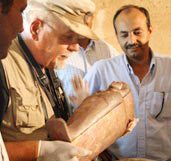Hope for the discovery of a royal mummy in the Valley of the Kings was rekindled this week as a small gilded coffin was uncovered in a mysterious chamber known as KV63.
 |
|
Archaeologists studying the infant-shaped coffin. (Photo: Discovery) |
Discovered in February by a team of archaeologists from the University of Memphis, led by Otto Schaden, KV63 still holds many mysteries.
Buried 4 meters beneath rubble, only 4.8 meters from the resting place of King Tutankhamun, the chamber has become the 63rd tomb found since the valley was first mapped in the 18th century.
This is the first chamber discovered since the young king was found in 1922.
Since then, seven anthropoid wooden coffins with vibrant patterns have been found in the chamber, surrounded by 28 sealed clay jars.
The pottery and wine jars bear labels identical to those found in King Tut’s tomb, indicating this site dates back to the 18th Dynasty (1539-1292 BC), the era of pharaohs such as the warrior king Amenhotep I, Queen Hatshepsut, the heretic king Akhenaten, and young King Tutankhamun.
Initially, excitement soared when the team found a mysterious site on the west bank of the Nile outside Luxor. It was speculated that this could be a burial area for many pharaohs.
“It was one of the most exciting moments of my life when I first peeked into the tomb and saw the coffin inside,” said leading Egyptian archaeologist Zahi Hawass.
However, the joy was short-lived. No mummy was found when the coffin was opened. Instead, dust, broken pottery, linen, and salts for embalming were scattered inside.
“I believe that KV63 is a chamber storing items used in the mummification process,” Hawass stated.
But the new discovery suggests that KV63 is not an ordinary storage room. Something unusual occurred here. Archaeologists found several jars, containing broken pottery, that had been smashed into pieces and scattered throughout the coffin. According to Schaden, it is strange that the embalmers would take sealed jars, break them, and place them in the coffin.
The mystery deepened when a child-sized coffin was opened. To Schaden’s surprise, the coffin did not contain a mummy but was filled with pillows. Hidden beneath these pillows, archaeologists found another gilded coffin shaped like an infant, of quality fit for royalty.
This discovery has raised new questions: What exactly is KV63? A royal Egyptian tomb? A storeroom for mummification items, or something else?
Schaden believes that the ultimate answer will come when the seal on the final coffin is broken. There remains a possibility that this coffin contains a royal mummy.
Schaden noted that if the final coffin holds a mummy, it could be someone the embalmers intended to hide. This might be Ankhesenamun, the wife of King Tut. One of the inscriptions found in KV63 contains the term “pa-aten,” a part of her name.
M.T.


















































